
The land the Trust hopes to purchase in the foreground and the rest of the nature reserve beyond.
Let the meadows bloom
WE WON!
Durham Wildlife Trust is delighted to announce an award of £540,000 from Biffa Award. This is a huge win for nature, but there is still more to do.
Thanks to supporters for providing the 10% match funding required, the Trust has been successful in its application to the Biffa Award as part of the Government's Landfill Communities Fund, and now, Durham Wildlife Trust can purchase land adjacent to the access road at Rainton Meadows (Mallard Way). The area of land successfully buffers the reserve from nearby housing developments. It is a combination of rough pasture, hedgerow and wetland areas and although not currently managed for wildlife, the area holds significant wildlife interest and is home to breeding willow tit and overwintering curlew.
Increasing the size of Rainton Meadows Nature Reserve is great news for nature and for people, please do donate today and support the future of Rainton Meadows.
In June, Durham Wildlife Trust set about fundraising £54,000 which would be used as match funding for an application to the Biffa Award for £540,000. The sum which would both secure the land and begin initial fencing works. Within one week of launching, the Let the Meadows Bloom appeal raised the amount needed for the match funding and eventually closed on £80,000 raised in total for the project. This additional support was much needed as complications around a required easement, led to higher-than-expected legal fees, however the funds raised above the target amount have enabled the Trust to cover these without drawing down from core funds. Now, the Trust is seeking support to further enable nature restoration on the new land.
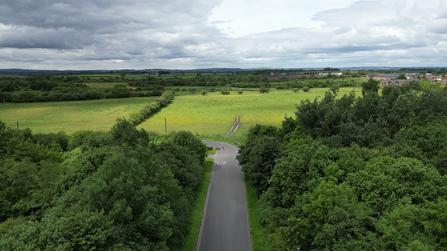
The existing view of the road into Rainton Meadows, showing the land at risk from development in distance.
The land has incredible potential to deliver nature recovery, particularly by creating species rich grasslands – over 97% of the UK's species-rich grassland has been lost in less than a century and that habitat now covers just 1% of land.
Additional plant species will be introduced to the site using green hay from the neighbouring Rainton Meadows reserve and conservation grazing implemented to help produce species rich grassland. Ponds and wetland habitats will be created in the low-lying areas and hedges planted to screen the site and prevent disturbance of target species such as curlew and lapwing. Viewing areas will be created to allow the public to enjoy the wildlife. Further fundraising will enable the Trust to deliver these ecological and access enhancements. If you are able to, please consider donating today and supporting new habitat creation at Rainton Meadows.
Rainton Meadows and the Trust’s adjoining Joe’s Pond Nature Reserves together form an important and freely accessible green space for the local community and are the Sunderland area’s largest and most important nature reserve. The new fields had previously been the subject of an outline planning application, which although unsuccessful on that occasion, would have destroyed the existing wildlife interest and would have had an incredibly detrimental impact on the wildlife abundance of Rainton Meadows, which has taken decades to develop. By purchasing the land, Durham Wildlife Trust has put an end to continued development attempts, protecting the species the area already supports and safeguarding the future of Rainton Meadows Nature Reserve.
Increasing the size of Rainton Meadows Nature Reserve is great news for nature and for people, please do donate today and support the future of Rainton Meadows.
Donate to support Rainton Meadows Nature Reserve
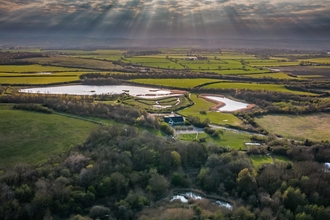
Donate £150
A donation of £150 could help dig out new wetland pools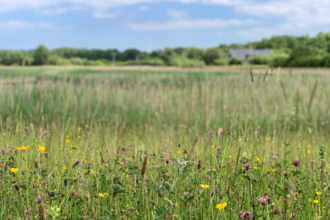
Donate £50
A donation of £50 could create 10m2 of wildflower meadow
Donate £15
A donation of £15 could plant three native treesHistory of Rainton Meadows and Joe’s Pond
There is a rich industrial heritage associated with Rainton Meadows and Joe’s Pond. In the 1800s the area formed part of the Rainton Collieries, where drift mines and spoil heaps covered the landscape. Nicholson’s pit was one the most productive, the remanence of its former pumping station can still be seen when walking the coalfield way between Joe’s Pond and Rainton Meadows.
A brickworks to the east of the site, dug clay from the ground to fire bricks which supplied the drift mines and in one year (1823) reportedly produced more than 800,000 bricks, demonstrating the size of the colliery operations. One flooded clay pit, stocked with fish and used as a recreational pond by the colliery and known as Nicholson’s pond at the time, came under the custodianship of Joe Wilson, who tended to the pond with care, creating an oasis for wildlife. Upon Joe’s retirement, Durham Wildlife Trust purchased the pond from the coal authority, naming it Joe’s Pond and opening it as a nature reserve in 1970, later inviting David Attenborough and David Bellamy to open a boardwalk there. Inland open bodies of water were rare in the area at the time and as such an abundance of wetland birds, amphibians and invertebrates could be found at Joe’s Pond, it was designated as a Site of Special Scientific Interest in 1984.
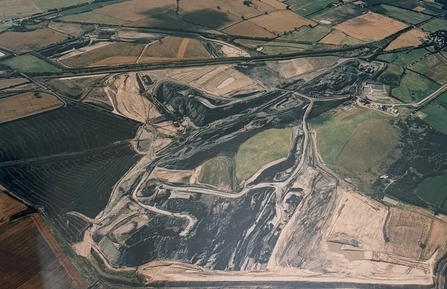
An aerial photograph of Rainton Meadows before it was a nature reserve
Following the closure of the drift mine collieries in the 80s, a movement towards opencast coal operations swept the region. In 1991, planning permission was granted for UK coal to opencast the land surrounding Joe’s Pond, including the large spoil heap, famous with locals and seen for miles around. Many opencast operations had returned to arable land upon closure, but at that time, of ‘milk lakes’ and ‘grain mountains’ across Europe, Sunderland Council made a bold and progressive decision to create Sunderland’s largest nature reserve. The Trust at the time held concerns relating to the open cast operations and ensured additional measures including a reed bed zone were put in place to buffer Joe’s Pond from the coal extraction.
In a matter of only 4 years, the coal extraction was completed, lower grade coal and brick shale removed from the spoil heap and the area re-landscaped. The Trust, Sunderland Council and UK coal worked closely to plan and implement the restoration and in 1996, the Trust moved its headquarters into the old coal offices onsite, where it remains. Thousands of trees were planted in the early days, wildflower seed mixes sewn and the ponds and paths created. Very quickly, particularly wetland species from Joe’s Pond were able to expand into Rainton Meadows, growing their range and numbers. As the plant life has developed on the reserve, so too have the number of species and abundance of insects. Habitat features on the reserve continue to develop with the Trust in recent years creating seasonal ponds, new reedbed areas and installing new viewing screens both to encourage more wildlife and to offer more opportunities to enjoy nature on site.
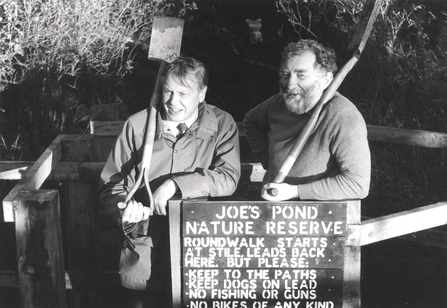
David Attenborough and David Bellamy at Joe's Pond
Donate to support Rainton Meadows Nature Reserve

